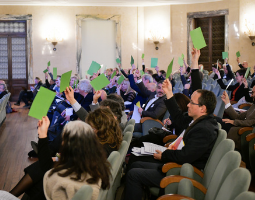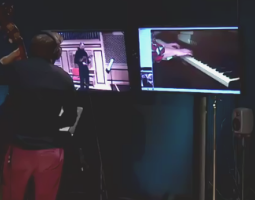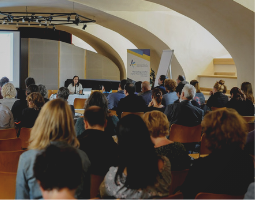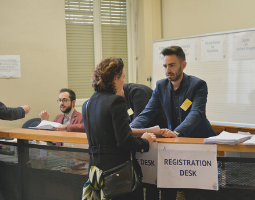The Digitisation of Erasmus+ in Higher Music Education
Drawing on a decade of experience with the digitisation of the Erasmus processes in higher music education and on the 2025
Survey among AEC members on the Digitisation of Erasmus, the AEC issued a Position Paper on the Digitisation of Erasmus outlining the opportunities, challenges, and sector-specific needs related to the Erasmus Without Paper
(EWP) ecosystem, advocating for inclusive and tailored digital solutions for HMEIs.
Read the 2025 AEC Position Paper on the Digitisation of Erasmus Procedures
AEC Project for a European Online Application System (EASY) for mobility among higher music education institutions
It was 2016 and the International Relations Coordinators of AEC member institutions have been suggesting for some years that AEC could develop a common European online applications system for ERASMUS and other mobility schemes applications, in order to overcome various obstacles such as the amount of paper work and the proliferation of different online systems and procedures. In the framework of the European Funded project FULL SCORE, a task force of international relations experts (a subgroup of the AEC IRCs working group), supported by the IT company ASIMUT, selected the Estonian company Dreamapply to provide an IT solution which could meet the ambitious and unique needs of such a system at European level. With the input of the task force, the company has released the first version of the European Online Application System (EASY) in December 2016. The system has been tested during the academic year 2016-2017 by the 41 AEC members institutions which took part in the first pilot phase. In 2023, in its 7th year of operation, EASY counted more than 120 institutions (including art institutes) who joined the system as full internal users, exchanging more than 8.000 applicaitons between each other and with external institutions also in other fields such as dance, theatre, fine arts, design, architecture, film and media.
However, because of the recent development of Erasmus Without Papers (EWP), which became the standard adopted by the European Commission for its Erasmus Programme, the system had to be migrated to another platform able to guarantee fully compatibility and interoperability with the requirements and protocols of the EWP Network. That is why since early 2023 a new platform for EASY has been provided by the Austrian company SoP, whose product Mobility Online – fully compatible and connected with EWP – has been shaped and adapted to the needs of the AEC consortium, creating the brand new EASY Mobility Online system (EASY MO). The system has undergone several testing and fine tuning phases and can now to welcome the needs of the international offices of higher music and arts education institutions.
Have a look to the New EASY Mobility Online System.
What are the benefits of using EASY Mobility Online?
- Reducing paper work
- Adapting to the various technical and structural requirements of AEC members institutions.
- The students will be able to autonomously submit online applications (audio/video) for more than one receiving institution and (if accepted) choose and confirm their final mobility destination
- The international offices will be able to handle the relations with their partners; verify, approve, return, forward applications; monitor the applications’ status; finalize procedures.
- The teachers and faculty management will be able to receive applications, submit evaluations, send feedback to international office
Why EASY Mobility Online is so special – a collaborative effort
- It is the first and only system of this kind being multi-national and subject-based
- It follows the same procedure for all institutions, but it is at the same time fully costomizable by each institution
- Incoming and outgoing applications are handled by the same system
- System developments are centrally controlled by the AEC with direct inputs from the users
- Possibility ot connect EU Erasmus Without Paper
- The more institutions join, the better the system works
- The users can refer to fellow IRCs in the EASY task force for questions and help
What the Student can do with EASY Mobility Online
• Fill in application form (including study plan)
• Upload documents and media files
• Edit own data
• Confirm final decision
What the Coordinators can do with EASY Mobility Online
• manage relations with partner institutions
• nominate students to apply for exchange
• share applications with media files with teaching committee
• send out acceptance letters with customizable templates and attachments
• generate exportable tables of applications
Highlights of the system
• automatic emails
• email notifications from the system to the IRCs
• automatic nominations email to external institutions
• automatic confirmation of nominations from external institutions
• export of application data in Excel
- ae tool to fill in the Learning Agreement, editable by both coordinators and students, who can put their electronic signature, save and print the documents of parts of it
New EASY Task Force 2025
Sara Primiterra – AEC Office – EASY Project Manager
Jose Luis Fernandez – Conservatorio Superior de Musica de Vigo, Spain
Noemi Parraghy – Bruckner University Linz
Ruth de Graaf-Fleet – Amsterdam Consevatoire
Ly Tran – Musikhochschule Weimar
Lucia Di Cecca – Conservatorio di Musica Santa Cecilia, Rome – external institution
Laura Diethart and Ivan Calfa – SoP Mobility Online
do you have questions or comments to the Easy Task Force? please mail Sara at events@aec-music.eu
How to Use EASY Mobility Online?
Want to (re) join in 2026? Please fill in the EASY MO 2026 Subscription Form. Deadline 10th October 2025 – SUBSCRIPTIONS ARE NOW CLOSED
Do you want to know how the system works? Watch the EASY MO workshop 2024 held in Dublin by the EASY MO Project Manager Sara Primiterra and the IT company SoP and have a look at the ppt describing the process.
Updated Manual coming up on December 2025
To receive manual for students, please write to events@aec-music.eu
How much does it cost to join EASY?
Fees 2026
| Total Number of Applicants (outgoing+incoming) | Price (+VAT) |
| More than 200 | 1800 euro |
| From 199 to 80 | 1600 euro |
| From 79 to 40 | 1300 euro |
| From 39 to 16 | 900 euro |
| From 15 to 1 | 500 euro |
Interested in joining EASY Mobility Online as internal institution?
Subscription for 2026 are closed.
contact Sara Primiterra for any question at events@aec-music.eu
Institutions Joining the EASY Mobility Online as internal institutions in 2026 – 7o institutions
Austria
Universität Mozarteum Salzburg
Stella Vorarlberg Privathochschule für Musik, Feldkirch
Gustav Mahler Private University of Music, Klagenfurt
Anton Bruckner Private University, Linz
Joseph Haydn Privathochschule Eisenstadt
JAM MUSIC LAB Private University for Jazz and Popular Music Vienna
Belgium
Conservatoire royal de Bruxelles
Institut Supérieur de Musique et de Pédagogie (IMEP), Namur
Bulgaria
National Academy Of Music ” Pancho Vladigerov”, Sofia
Czech Republic
Music and Dance Faculty, Academy of Performing Arts in Prague
Estonia
Estonian Academy of Music and Theatre, Tallinn
Finland
University of Arts Helsinki: Sibelius Academy and Faculties of Fine Arts and Theatre
France
Conservatoire national supérieur de musique et de danse de Lyon
Conservatoire national supérieur de musique et de danse de Paris
PSPBB, Paris
Georgia
Vano Sarajishvili Tbilisi State Conservatoire
Germany
Musikhochschule Lübeck
Staatliche Hochschule für Musik und Darstellende Kunst Stuttgart
Hochschule für Musik Carl Maria von Weber Dresden
Hochschule für Musik und Theater München
Hochschule für Musik und Tanz Köln
Hochschule für Musik Freiburg
Hochschule für Musik Würzburg
Hochschule für Musik und Theater Hamburg
Hochschule für Musik Karlsruhe
Hochschule für Musik, Theater und Medien Hannover
Hochschule für Musik Nürnberg
Musikhochschule Münster
Hungary
Liszt Ferenc Academy of Music, Budapest
Ireland
Royal Irish Academy of Music, Dublin
TU Dublin Conservatory of Music and Drama (formerly DIT), Dublin
Italy
Saint Louis Music Center Srl, Rome
Conservatorio di Musica “A. Pedrollo”, Vicenza
Conservatorio di Musica “N. Piccinni”, Bari
Conservatorio di Musica “A. Scontrino”, Trapani
Conservatorio Di Musica “B. Marcello”, Venice
Conservatorio di Musica “A. Corelli”, Messina
Conservatorio di Musica “U. Giordano”, Foggia
Conservatorio di Musica “Giuseppe Martucci”, Salerno
Conservatorio di Musica “Lucio Campiani”, Mantova
Conservatorio di Musica ”Francesco Antonio Bonporti”, Trento
Conservatorio di Musica Statale “Vincenzo Bellini”, Palermo
Conservatorio di Musica Statale di Matera
Conservatorio Vincenzo Bellini di Caltanissetta
Conservatorio di Musica “G.Verdi” di Milano
Conservatorio di Musica “P.I. Tchaikovsky” di Nocera Terinese
Istituto di alta formazione musicale Conservatorio “Claudio Monteverdi” di Bolzano
Conservatorio di Musica “Luigi Cherubini” di Firenze
Conservatorio Statale di Musica “A.Vivaldi” di Alessandria
Conservatorio di Musica “L. Marenzio” di Brescia
Conservatorio di Musica Tito Schipa di Lecce
Conservatorio di Musica “San Pietro a Majella” di Napoli
Conservatorio di Musica “G.Verdi” di Ravenna
Latvia
Latvian Academy of Music, Riga
Lithuania
Lithuanian Academy of Music and Theatre, Vilnius
The Netherlands
Amsterdam University of the Arts
Codarts University of the Arts, Rotterdam
Norway
Norwegian Academy of Music, Oslo
University of Bergen, The Grieg Academy, Bergen
Barratt Due Institute, Oslo
Poland
Stanisław Moniuszko Academy of Music in Gdańsk
Portugal
ESMAE Porto
Academia Nacional Superior de Orquestra, Lisbon
Romania
The National Academy of Music Gheorghe Dima in Cluj-Napoca
Slovenia
University of Ljubljana Academy of Music, Ljubljana
Spain
Escola Superior de Música de Catalunya, Barcelona
Conservatorio Superior de Mùsica de Vigo
Conservatorio Superior de Música “Joaquín Rodrigo” de Valencia
Musikene. Higher school of Music of the Basque Country, San Sebastian
Conservatori Liceu, Barcelona
Conservatorio Superior de Danza de Alicante (CSDA)
Conservatorio Superior de Música de Castilla-La Mancha, Albacete
Conservatorio Superior de Música de Aragón, Zaragoza






